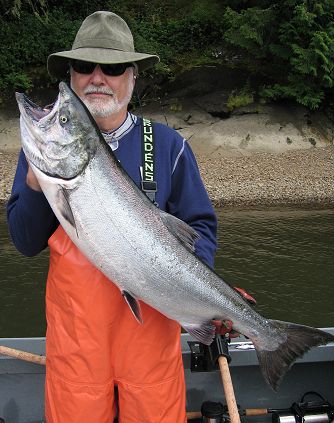forum
library
tutorial
contact

Summer Chinook Angling Ends Upstream of Bonneville Dam,
Treaty Fishing Gets Three More Days
by Staff
Columbia Basin Bulletin, July 13, 2018
|
the film forum library tutorial contact |

|
Summer Chinook Angling Ends Upstream of Bonneville Dam,
by Staff
|
"Adult counts are less than expected based on the pre-season forecast and jack counts are the lowest to date since 1999," it says.
 The number of summer chinook salmon expected to enter the Columbia River took another nose dive last week when biologists that estimate those numbers downgraded the run another 15 percent.
The number of summer chinook salmon expected to enter the Columbia River took another nose dive last week when biologists that estimate those numbers downgraded the run another 15 percent.
As a result, fisheries managers from Oregon and Washington closed angling to chinook fishing from Bonneville upstream to the Oregon and Washington border as of Saturday, July 7 at 12:01 am. Chinook angling will be closed through July.
The U.S. v Oregon Technical Advisory Committee reduced its estimated run size for summer chinook from the preseason forecast of 67,300 fish to 52,000 at its June 25 meeting, an estimate that caused the two-state Columbia River Compact to close angling downstream of Bonneville Dam as anglers had already exceeded their allocation for the area.
TAC then reduced that estimate to just 44,000 fish, down 35 percent from the preseason estimate, at its July 2 meeting and so the two states shut fishing down from Bonneville Dam upstream to the state border.
The Compact met again this week to approve a three-day extension for Treaty commercial fishing that the Columbia River Inter-Tribal Fish Commission said will closely approach their allocation for summer chinook.
That allocation, according to the Compact's Summer Fact Sheet No. 2, for Treaty commercial fisheries based on the lower run size estimate is 10,627 summer chinook. Catch from Treaty commercial fisheries, including platform fishing, is projected to hit 10,038 after the three-day fishing extension July 11 to 13, leaving just 589 fish for the platform fishery through July, according to Stuart Ellis of CRITFC and also lead of TAC.
Tucker Jones of the Oregon Department of Fish and Wildlife reluctantly recommended the additional fishing days for tribes, but with reservations based on the falling run size estimates and how close to the allocation the catch will be by July 13.
Non-treaty commercial and recreational fisheries also receive as their allocation 10,627 of the summer chinook, equal to the Treaty fishery. However, it is more complicated with the non-treaty fisheries because other fisheries are counted within their share, Ellis said. Those are:
Summer chinook pass Bonneville Dam from June 16 through July 31. As of July 9 passage at the dam was 32,029 adults and 2,236 jack salmon. Some 79 percent of those are of hatchery origin, the Fact Sheet says.
"Adult counts are less than expected based on the pre-season forecast and jack counts are the lowest to date since 1999," it says.
Through July 9, 182,458 sockeye had passed the dam. Last year on July 9, 80,816 sockeye had passed the dam. The 10-year average is 297,222.
The tribes modeled their allocation of 14,000 sockeye based on a conservative 200,000 fish, instead of TAC's estimated 209,000. They estimate the catch of sockeye will be 9,454, leaving 4,546 sockeye remaining to catch after July 13.
Some 6,843 Skamania steelhead were counted at the dam as of June 30, including 2,854 unclipped fish, and 4,507 A- and B-Index were counted as of July 9.
The Fact Sheet explains that the upriver Skamania steelhead run includes steelhead passing Bonneville between April 1 and June 30. A-Index and B-Index steelhead include steelhead passing Bonneville between July 1 and October 31. Steelhead harvested in the Bonneville Pool between April 1 and June 30 are considered to be Skamania stock steelhead. Steelhead harvested upstream of The Dalles Dam prior to July 1 are considered to be part of the 2017-18 A- and B-Index run. Steelhead harvested in Zone 6 in July are considered to be part of the 2018-19 A- and B-Index run.
The estimated catch of steelhead for Treaty fishers will total 916 fish by July 13.
The July 10, 2018 Compact Action Notice that outlines the Compact actions this week.
Related Pages:
Snake River Sockeye: Lowest Return Since 2007, Captive Broodstock Program Increases Spawners by Staff, Columbia Basin Bulletin, 9/11/15
Related Sites:
Spring Chinook Fishing Extended With Increased Bag Limit; So Far, Jacks Passage Very Low by Staff, Columbia Basin Bulletin, 6/8/18
With Run Downgrade, Summer Chinook Fishing Below Bonneville Dam Ends Early; Sockeye Above Forecast by Staff, Columbia Basin Bulletin, 6/29/18
learn more on topics covered in the film
see the video
read the script
learn the songs
discussion forum
